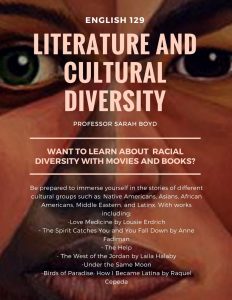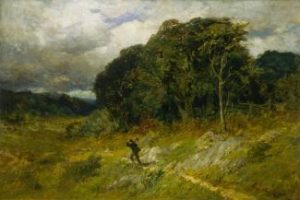Aidee Manzano and Emily Decker
ENGL 129 Literature and Cultural Diversity
Sarah Boyd, Dept of English and Comparative Literature
Fall 2018, UNC-Chapel Hill
Course Description:
English 129 – Literature and Cultural Diversity- is a course offered at Chapel Hill that emphasizes studies in four specific racial groups in the United States using US English-language literature. It fulfills the LA (literary arts), NA (North Atlantic World), and literature in the United States The course will only cover five ethnic groups: African American, Middle Eastern, Asian, Native American, and Latinx, but is not limited to these groups. This course will be used to further explore the pain and joy experienced while journeying to discover one’s’ identity as an American and as part of other peoples ethnic groups. Students will see the split worlds of others and hopefully gain a better understanding of the effects rejection/acceptance can have.
This course has chosen to concentrate solely on racial diversity so as to have time to briefly delve into a select number of racial groups. Unfortunately, not all groups can be touched on, which is why only five ethnic groups have been chosen to be the center of discussion. However, so we can look at multiple ethnic groups we will be omitting focus on other areas of diversity such as disability, gender, and LGBT issues. Even if some of those issues will be present in the readings, they will not be the main focus of the class. In order to give each group an equal amount of time, for two to three weeks the class will be structured around a certain group, with each one being assigned either one book and/or movie, and a few supplemental assignments. The supplemental assignments will be used to further enhance your understanding of the material and help you draw your own conclusions, as well as to connect the topics seen in the works with present day issues. The class will first start out by concentrating on Native American culture, with Love Medicine (1984). This book is written by Native American author, Louise Erdrich, and uses various short stories to tell the stories of a family living on a reservation in North Dakota and their struggles with trying to connect to their past and culture, and trying to live and assimilate to the culture around them. The story also makes sure to describe the history and traditions of Native American culture through its interesting narrative style and themes. The Spirit Catches You and You Fall Down (1997) written by American author, Anne Fadiman, will be used to look at Asian culture. This book looks at how differences in cultural beliefs, and a lack of understanding can lead to disastrous consequences as seen through a real life case of a Hmong child in the US. This book uses every other chapter to discuss the broader themes of Hmong culture, customs, and history, and the issues with immigration as seen with discrimination and assimilation. African American culture will be covered by watching the movie The Help, which came out in 2011, but is a period drama that looks to uncover racism and tell the story that is seen in the South during the 1960s. This section will also be paired with assignments that aim to give you a chance to reflect on racism back then compared to racism now. Middle Eastern culture, which has become a prevalent topic in the United States recently, will be looked at through the book The West of the Jordan (2003) written by Laila Halaby, an Arab and American author. It follows the lives of four cousins, living in either Jordan or the United States, as they struggle to make sense of their national and ethnic identities. The last group that will be talked about is Latinx, and will consist of the book Bird of Paradise: How I Became Latina (2013) by Raquel Cepeda, and the movie Under the Same Moon (2007). Under the Same Moon tells the story of a boy who tries to cross the border from Mexico to the United States to find his mother who illegally immigrated earlier in order to provide for her son. This movie will provide an insight into immigration and the reasons for immigration, topics especially important today. Birds of Paradise: How I Became Latina is the last book because it tells a story that can be applied to all the different racial groups we have focused on. The book is separated into two parts, Part I and Part II. Part I focuses on the author’s childhood and early adulthood in New York. Part II depicts her journey to discover her true ethnic identity in order to help her reconcile her family conflicts and bring closure to her struggle to figure out her heritage. The main purpose of the class is to be able to gain insight into different ethnic identities, what culture and heritage means to these people and their struggles to connect with their own heritage and those of others. Once the class is finished you should be able to create connections between what is read and seen to current events, as well as to become more informed on the topic of racial diversity.
Schedule:
Week 1:
Mon: Love Medicine: start – pg. 70
Wed: Love Medicine: pg. 71 – 130
Read Louise Erdrich’s “Indian Boarding School Runaways” and “I Was Sleeping Where the Black Oaks Move”
Week 2:
Mon: Love Medicine: pg. 131 – 190
Wed: Love Medicine: pg. 191 – 250
Short response due before Week 3
Week 3:
Mon: Love Medicine: pg. 250 – end
Wed: The Spirit Catches You and You Fall Down: start – pg. 60
Week 4:
Mon: The Spirit Catches You and You Fall Down: pg. 61- 120
Wed: The Spirit Catches You and You Fall Down: pg. 121 – 181
Podcast due before Week 5
Week 5:
Mon: The Spirit Catches You and You Fall Down: pg. 182 – 241
Wed: The Spirit Catches You and You Fall Down: pg. 242 – 301
Week 6:
Mon: The Spirit Catches You and You Fall Down: pg. 301 – end
Wed: Look up information from the actual case described in the book
Short Response due before Week 7 (respond about similarities and differences, as well as why author chose to tell the story the way she did)
Week 7:
Mon: The Help
Short response for class on wed. about what racism looks like now, is there still some present or no? Did The Help do a good job at portraying what it was like in the 1960s or no?
Wed: The West of the Jordan start – pg. 60
Research the history of Jordan and the United States.
Podcast due before Week 8
Week 8:
Mon: The West of the Jordan pg. 61 – 160
Wed: The West of the Jordan pg. 161 – end
Short response about whether or not you think the book broke or reaffirmed Arab stereotypes and why.
Week 9:
Mon: Review for Midterm
Wed: Midterm
Week 10:
Mon: Under The Same Moon part 1
Wed: Under The Same Moon part 2
Week 11:
Mon: Watch Under the Same Moon
Interview POC due before Week 13
Wed: Birds of Paradise start – pg. 60
Short response
Week 12:
Mon: Birds of Paradise pg. 61- 120
Wed: Birds of Paradise pg. 121- 180
Week 13:
Mon: Birds of Paradise pg. 181- 230
Wed: Birds of Paradise pg. 231- 280
Week 14:
Mon: Birds of Paradise pg. 280-end
Wed: Start Final Paper
Week 15:
Mon: Look up some info so can participate with guest speaker
Wed: Guest Speaker
Final Paper Due
Week 16:
Mon: Review
Wed: LDOC Get ready for Final!
Final!

